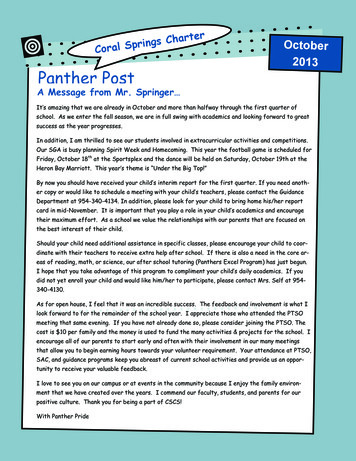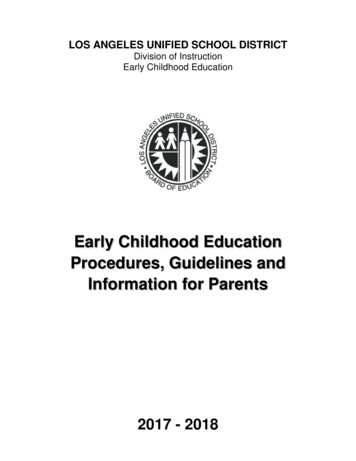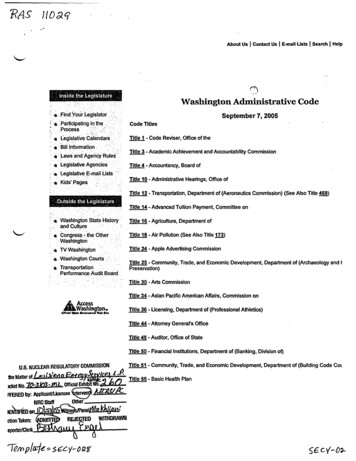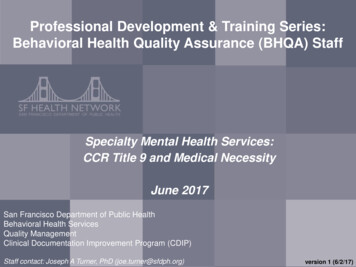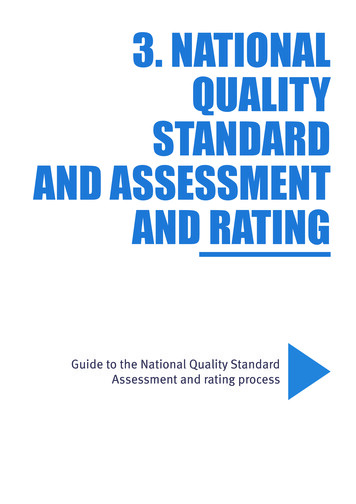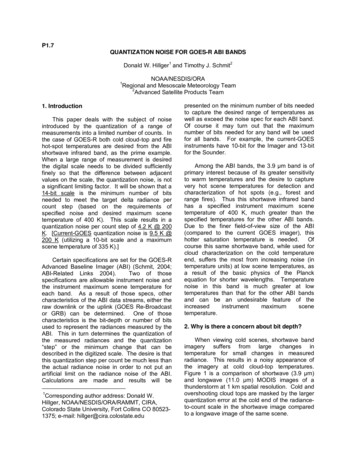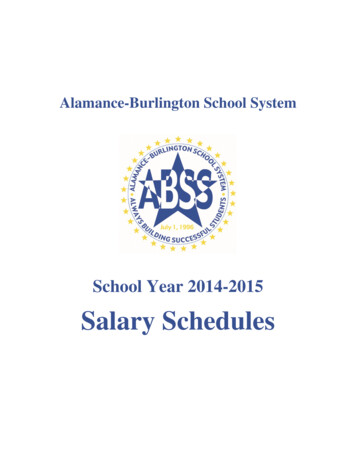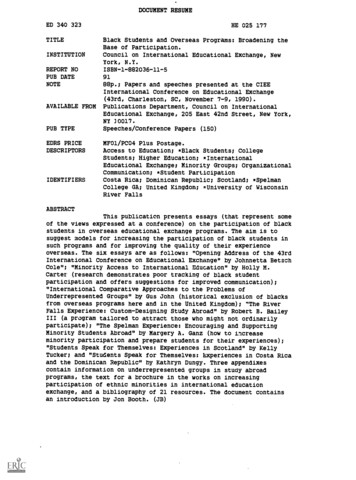
Transcription
DOCUMENT RESUMEED 340 323TITLEINSTITUTIONREPORT NOPUB DATENOTEAVAILABLE FROMPUB TYPEEDRS PRICEDESCRIPTORSIDENTIFIERSHE 025 177Black Students and Overseas Programs: Broadening theBase of Participation.Council on International Educational Exchange, NewYork, N.Y.ISBN-1-882036-11-59188p.; Papers and speeches presented at the CIEEInternational Conference on Educational Exchange(43rd, Charleston, SC, November 7-9, 1990).Publications Department, Council on InternationalEducational Exchange, 205 East 42nd Street, New York,NY 30017.Speeches/Conference Papers (150)MF01/PC04 Plus Postage.Access to Education; *Black Students; CollegeStudents; Higher Education; *InternationalEducational Exchange; Minority Groups; OrganizationalCommunication; *Student ParticipationCosta Rica; Dominican Republic; Scotland; *SpelmanCollege GA; United Kingdom; *University of WisconsinRiver FallsABSTRACTThis publication presents essays (that represent someof the views expressed at a conference) on the participation of blackstudents in overseas educational exchange programs. The aim is tosuggest models for increasing the participation of black students insuch programs and for improving the quality of their experienceoverseas. The six essays are as follows: "Opening Address of the 43rdInternational Conference on Educational Exchange" by Johnnetta BetschCole"; "Minority Access to International Education" by Holly M.Carter (research demonstrates poor tracking of black studentparticipation and offers suggestions for improved communication);"International Comparative Approaches to the Problems ofUnderrepresented Groups" by Gus John (historical exclusion of blacksfrom overseas programs here and in the United Kingdom); "The RiverFalls Experience: Custom-Designing Study Abroad" by Robert B. BaileyIII (a program tailored to attract those who might not ordinarilyparticipate); "The Spelman Experience: Encouraging and SupportingMinority Students Abroad" by Margery A. Ganz (how to increaseminority participation and prepare students for their experiences);"Students Speak for Themselves: Experiences in Scotland" by KellyTucker; and "Students Speak for Themselves: Experiences in Costa Ricaand the Dominican Republic" by Kathryn Dungy. Three appendixescontain information on underrepresented groups in study abroadprograms, the text for a brochure in the works on increasingparticipation of ethnic minorities in international educationexchange, and a bibliography of 21 resources. The document containsan introduction by Jon Booth. (JB)
.AI111.1"' t%.:.'tfi441.,P4rk,,yf.or,m4J.v. N.kit.4 tle.'TV' NA,, ,as.94tA,AM.1.4 t.44114. /.70,4;;T".1U.* OtPARTMIINT OP IOUCAT)011Office of Educational Peesorth and InverovanwlEDUCATIO tAt. RESOURCES INFORMATIONCENTER (ERIC)"PERMISSION TO REPRODUCE THISMATERIAL t'AS BEEN GRANTED BYCT PPNit* cl-icumint has been rpioducod agIfCetwad from the person or ofeenif ahemoriginating ItO Minor changss haws bean made to motorstOttfoduclion QualttyPoints ol vow 01 opinions slated in tam doeu .11 M IIfront do noI neceasanly radrawnt officialOERI politson of pottyTO THE EDUCATIONAL RESOURCESINFORMATION CENTER (ERIC)"Council onlnternatipnalEducatioinalExchangeBEST COPY AVAILEI
BLACK STUDENTS ANDOVERSEAS PROGRAMS:BROADENING THE BASE OFPARTICIPATION
BLACK STUDENTS ANDOVERSEAS PROGRAMS:BROADENING THE BASE OFPARTICIPATIONCouncil on International Educational ExchangedakLit
Council on International Educational ExchangeThe Council on International Educational Exchange is a private, nonprofit,membership organi zation, incorporated in the United States with internationaloffices, affiliations, and representation. CIEE, founded in 1947 by a small groupof organizations active in international education and student travel, wasestablished to restore student exchange after World War II. In its early yearsCIEE chartered ocean liners for transatlantic student sailings, arranged groupair travel, and organized orientation programs to prepare students and teachersfor educational experiences abroad. Over the years CIEE's mandate hasbroadened dramatically and its activities and programs abroad have spreadbeyond Europe to Africa, Asia, and Latin America. Today CIEE develops andadministers a wide variety of study, work, and travel programs for students atthe secondary, undergraduate, graduate, and professional levels.Published by the Council on International Educational Exchange, 1991.Copyright 1991 by the Council on International Educational Exchange.ISBN: 1-882036-11-5tir
Table of ContentsIntroductionJon BoothviiIII Opening Addi ess of the 43rd InternationalConference on Educational ExchangeJohnnetta Betsch Cole1Minority Access to International EducationHolly M. Carter9International Comparat% ,e Approachesto the Problems of Uncle. represented GroupsGus John21The River Falls Experience:Custom-Designing Study AbroadRobert B. Bailey HI31The Spelman Experience: Encouragingand Supporting Minority Students AbroadMargery A. Ganz43Students Speak for Themselves: Experiences in ScotlandKelly Tucker55Students Speak for Themselves:Experiences in Costa Rica and the Dominican RepublicKathryn Dungy59Appendix I: Information and Ideason Underrepresented Groups in Overseas Programs65Appendix II: Increasing Participation of EthnicMinorities in Study Abroad69Appendix III: Study, Work, and Travel Abroad:A Bibliography75
IntroductionThe origins of this book lie in a subject that is of central concernto higher education in the United States today: how to dealeffectively with diversity issues. Diversity has been an area ofconcern in international education for several years. One of thefour general recommendations of the 1988 CIEE report, Educating for Global Competence: The Report of the Advisory Council forInternational Educational Exchange, was as follows:Special efforts should be made to identify and encourage bothstudents from underrepresented academic and social groupsand students with leadership ability, to incorporate studyabroad in their academic programs, and to do so in a greaterrange of subjects.In the 1990 report, A National Mandate for Education Abroad:Getting On With the Task, the following statement is made:Efforts to expand the number of undergraduates who studyabroad must address the lack of diversity among them. Traditionally, American study abroad students have come fromaffluent, middle or upper class, white, professional familiesrather than the broad spectrum of American society.It is a priority of the Council on International Educational Ex-change to increase the number of participants from underrepresented groups in overseas programs. In 1988, CIEE's Boardof Directors set up the Committee on Underrepresented Groupsin Overseas Programs in order to coordinate that effort. Thetheme of CIEE's 43rd International Conference on EducationalExchange, held November 7-9, 1990, in Charleston, SouthCarolina, was International Education: Broadening the Base ofParticipation. At that conference a number of presentations weremade which dealt specifically with the issue of sending blackstudents abroad.The essays bound together in this volume represent some ofthe views expresse -I on the participation of black students inoverseas programs during the Charleston conference. Botheducators and students have shared their insights, providingvii
models for increasing participation of black students in studyabroad programs and for improving the quality of their experienceoverseas.Setting the tone of the discussion is Johnnetta Cole's OpeningAddress of the 43rd International Conference on EducationalExchange. This inspirational speech captures the collective determination of participants in the conference to improve the overallstate of minority participation in educational exchanges. But Coleproceeds to fovis on particular obstacles that black students mustovercome, outlining tactics to assist them in that struggle.Following Cole's speech, Holly Carter and Gus John deal withbroad issues in minority access to international education. Withthe results of new research into study abroad departments at anumber of U.S. universities, Carter demonstrates that the participation of black students is not effectively tracked and suggestsnew ways for study abroad offices to communicate with under-represented groups. John shows how black students have beenhistorically excluded from study abroad not only in the U.S. butalso in the United Kingdom, and points to new issues facing thesestudents in a changing European order.In two case studies, Robert B. Bailey III and Margery A. Ganzdetail their own hands-on experiences in conducting undergraduate study abroad programs In The River Falls Experience:Custom-Designing Study Abroad, Bailey describes the programhe instituted at the University of WisconsinRiver Falls, whichhe has tailored to include and encourage students who might notordinarily study abroad. In The Spelman Experience: Encouraging and Supporting Minority Students Abroad, Ganz tells howSpelman College has increased the number of study abroadparticipants among its own students, as well as how its studentsprepare for their experience.Rounding off the discussion, two Spelitcin College students,Kelly Tucker and Kathryn Dungy, discuss their own experienceswith racial issues while studying abroad (Tucker in Scotland,Dungy in Costa Rica and the Dominican Republic). In doing so,they give valuable testimony to real problems of which professionals in the study abroad field may sometimes have an imperfect understanding.In addition to these chapters, three appendices provide, furtherinformation for those concerned with increasing the number ofminority students who study abroad. Information and Ideas on
Underrepresented Groups in Overseas Programs was prepared byCIEE's Committee on Underrepresented Groups in OverseasPrograms This resource identifies the various groups that areunderrepresented in study abroad programs, what barriers theyface, and what we can do, individually and collectively, to combatthem.Increasing the Participation of Ethnic Minorities in StudyAbroad contains the text that will be used in a brochure gearedto help study abroad advisers concerned with the issue at hand.The finished brochure will be available from CIEE early in 1992.Study, Work, and Travel Abroad: A Bibliography provides alist of key resources that should be included in the library of everystudy abroad office seeking to expand overseas study oppor-tunities for a wider cross-section of the student population.This book is but one of a series of ongoing efforts being madeacross the country to make overseas opportunities more accessible to a broad spectrum of people. CIEE will continue to devotetime to these issues at future annual conferences. We hope thisbook will be a thought-provoking and useful guide. We welcomeyour reactions and suggestions. Above all, we invite you to be partof the effort.Jon BoothChair, CIEE's Committee on Underrepresented Groups inOverseas ProgramsDirector, International Study and Travel Center, Universityof Minnesotaix
Opening Address of the 43rd InternationalConference on Educational ExchangeJohnnetta Bets& ColeColleagues all.Good afternoon. May I also express my pleasure in being partof a session that brings together participants in the 43rd International Conference on Educational Exchange and the NAFSARegion VII Annual Conference.What a wonderful collection of folks we are: faculty, staff, andstudents, all committed to promoting international education, notonly for the growth and development of individual students, butas a powerful tool to address the resurgence of xenopIrkia,racism, and other forms of bigotry which stalk our world. I wantto borrow from words used by Sojourner Truth when she urgedwomen to address a world turned upside down by men. I say tothis impressive gathering, "Why, we ought to be able to turn theworld right side up again!"Let me be a little more modest and say this: Let's work on it!And work on it we must.I fear that Mexican writer Carlos Fuentes is right when hesays: "What the U.S. does best is understand itself. What it doesworst is understand others." As Senator Paul Simon has put it,"We Americans simply cannot afford cultural isolation." We needto understand our co-inhabitants on this earth so that we cancompete effectively in an increasingly global economy. But we alsoJohnnetta Cole is President of Spelman College. At the time thispaper was presented she was a member of CIEE's Board ofDirectors and served as Chairperson of the 43rd InternationalConference on Educational Exchange, heid November 7-9, 1990,in Charleston, South Carolina. Cole's speech is available onvideo:ape for 10 from CIEE's Information and Student ServicesDepartment.
Black Students and Overseas Programsneed to better understand the diverse peoples of our world in theinterest of peaceful coexistence.It also seems to me that there is a direct relationship betweennational chauvinism and racial and cultural chauvinism. In onecase, the person who is narrow-minded at best, bigoted at worst,says: "I don't like and anyway rm superior to all of those folks inthose foreign countries." In the other case, the person says: "Idon't like and anyway I'm superior to all of these Hispanic, Asian,African, and Native Americans who have invaded my America."There is a definitive rise in blatant expressions of racism,anti-Semitism, and biased incidents against recent immigrantsto our nation. Any expression of bigotry is reprehensible and mustbe combatted. But for us of the academy, it is a particular concernto note the rise in racial incidents and violence on our college anduniversity campuses.The good news, of course, is that many colleges and universities are confronting the problem head-on and responding in anumber of ways from required courses in cultural diversity tomore concerted efforts to recruit and retain "minority" faculty,staff, and students.What is the number of black students studying abroad today?How has that number changed over time? And other "minority"students?Frankly, we don't know because we don't keep such statistics.I understand why: During earlier periods keeping such statisticswas not the correct thing to do. But this is a different time, andwe need those statistics in order to characterize the currentsituation and to monitor progress in broadening the involvementof students of color in overseas educational exchange.Without hard figures, nevertheless, we know the situation isnot good. Let me quote from a CIEE document that most of youknow, Educating for Global Competence: The Report of the Advisory Council for International Educational Exchange (1988):Students who study abroad are from a narrow spectrum of thetotal population. They are predominantly white females fromhighly educated professional families, majoring in the socialsciences or humanities. They are high achievers and risktakers. Many have had earlier overseas travel or internationalexperience. Whether by their own choice or lack of encourage-ment to do so, there are fewer men, members of minority2
Opening Addressgroups, students from nonprofessional and less-educatedfamilies, and there are fewer students from science, education,or business majors among undergraduates who study abroad.What this quote doesn't say is that in study abroad programsthere are yet other underrepresented groups: disabled studentsand older students. And we must continue to fight geographicalchauvinism. Study abroad should not be the possession of theNortheast corridor institutions.It is critical that we analyze why each of these groups participates in such small numbers in study abroad. For while thereis no doubt a shared factor or two among all these groups, thereare also very distinct obstacles at work. The reason men areunderrepresented is not the same reason that hardly any NativeAmerican men and women are studying abroad. The reason thatAfrican Americans are underrepresented is not the same reasonthat disabled or differently abled people rarely study abroad.That is the first good reason why I will turn now to addressunderrepresentation of only one group, African American students.A second reason is that I know a lot more about this group ofstudents than the others.Surely, there are several ways in which A3ian Americans,Hispanic Americans, Native Americans, and African Americansall face the same deterrents to studying abroad. But I'm notconfident enough about those similarities to ignore the differences and speak about "the minority population" of the UnitedSt ates.Of course, I also cannot claim to know and understand theviews of all black students either. What I can do is learn fromlistening to Spelman women who have studied abroad; reach backinto my memory and remember what it was like when as agraduate student I spent six months in Tours, France; draw onwhat my field, anthropology, tells me about cross-cultural andinterracial experiences; refer to what I know as one who hasstudied black American culture in the U.S., and lived it; and I cancount on plain ole common sense. With that "data base," I amfinally ready to addresu the question of the underrepresentationof African American students in international educational exchange.3
Black Students and Overseas ProgramsI want to do so in a very straightforward way by spelling outwhat I see as four mAjor obstacles to African Americans studyingabroad. There are no surprises here. In fact, I know thatthroughout the course of the conference, different colleagues andtwo Spelman students will take a look at this question and offersuggestions. Do attend these sessions and listen up. There will bemuch to learn.Colleagues: I think there are four barriers to black studentsengaging in international educational exchanga, The fact thatsome African American women and men do study abroad isevidence that it is possible to get around these barriers. They areclearly not of the same order of intensity, but here are the fourFs:oFaculty and StaffFinancesFamily and CommunityFearsFaculty and staff tend to encourage "the best students" toparticipate in special programs, compete foz awards and rewards,and indeed to apply for and go on study abroad programs. Manyfaculty, obviously not all, do not see black students in those terms.The "solution" is quite simply to educate faculty at PWIs(Predominantly White Institutions) to cast the study abroad netwidely to include black students.At HBCUs (Historically Black Colleges and Universities) theproblem is first that the faculty, indeed the institution, is oftenworking with far fewer resources to sustain a study abroadprogram And carrying out all the work of these programs may beviewed as a "luxury" that folks who teach four courses a semesterfeel they "cannot afford."This we do know: A study abroad program on any campus, likeany other program, thrives when there are persons who caredeeply about it, and where there is an administration committedto supporting it. I am convinced that once there are such folks onevery campus, we will see a mtkjor increase in the involvement ofAfrican American students in study abroad programs.The second of the four barriers is finances. Clearly, money isan important issue for any student considering studying abroad,4
Opening Addressbut this is particularly the case for black students. Why? Becauseour students are disproportionately found among students whosimply cannot attend college without substantial financial aid.Black students are more than three times as likely as whitestudents (38 percent vs. 13 percent) to come from families withincomes below 20,000. Under these conditions black studentshave come to rely heavily on financial aidespecially federalaidto enable them to attend college.Now clearly, not all black students are poor or on financial aid.There are black students of wealthy families and many of middleclass families. But if we want to substantially increase the number of African Americans studying abroad, we must make everypossible effort to allow students to use their fmancial aid duringa study abroad experience. In this sense, we must all energeticallysupport Representative William Ford's bill that would allow theuse of existing financial aid to study abroad.In addition, the administrations of our institutions need tofund-raise specifically for study abroad scholarships for black andother minority students.The third barrier to large-scale African American participationin study abroad programs is concern on the part of the students'family. Again, the case of black students seems to be simply amore intense expression of what other students experience.What parents are not concerned for the well-being of theirchildren? Will my child be safe? Will she eat properly? Will sheget enough rest? Is that the best crowd for him to hang out with?You don't think she's getting serious about him, do you?A black parent asks each and every one of those questions, butthen there is inevitably the most serious of all: How is racism overthere? Of course, the more unknown the place where one's childis going, the more this last question haunts you. And AfricanAmerican parents are less likely to have traveled abroad thanwhite American parents have.I have known the specific worry of a black parent concernedabout what racial attitudes and incidents my son, Aaron, wouldexperience as he studied for eighteen months in Japan.What is required, of course, is careful work with AfricanAmerican parents to help them feel comfortable with a studyabroad program for their son or daughter. It is a good idea to putparents in touch with other parents whose African American son5:11A
Black Students and Overseas Programsor daughter had a positive study abroad experiencea positiveone.The fourth and final barrier I want to discuss here is a blackstudent's own fear of encountering, miles away from home, "yetanother form of racism." The argument might be advanced:You've had to live with these attitudes and behaviors all of yourlife, so don't let racism be a deterrent to an otherwise fineexperience. The response of many of our students is that theyknow and on some level miderstand American racism, but whyventure into foreign variations on that everyday theme?Sometimes black students are accused of seeing racism underevery tree. I thought it would be helpful to share with you anexperience that Dr. Margery Ganz had with some of her Spelmanstudents.I was with one of my students in Italy four years ago when Iheard a little child ask his mother why my student's motherhad let her out without washinghow truly dirty she was; hewanted to come over and touch her to see if the dirt would ruboff. My student (who was one of three black students in a groupof 240) ignored it but later we talked about how often ithappened, how she felt and coped.How do we begin to protect African American students fromsuch experiences? Perhaps we can't, but there are a number ofthings that can be done to prepare them and minimize the hurt:1. During the orientation period, black students who havestudied abroad can be encouraged to participate; I thinkthey will make the point that despite racism, the experience was worth it2. During the orientation, talk about coping strategies3. Select host families with absolute care4. Set up programs in African and Caribbean countries. Atleast some African American students will return to campus without horror stories about blatant racism5. Try to send at least two African American students to thesame program so that they can support each otherClearly then, there are substantial obstacles which block manyblack students from participating in international educationalexchange. But it is also possible for us to assist students in movingaround these obstacles. We must do so, for without increased156
Opening Ackiressnumbers of black and other minority students in study abroadprograms, we present to the people of other lands a most distortedview of who America's people are. And when black students studyabroad, theylike all stile entsgain extraordinary insights andexperience extraordinary personal growth. As we say inanthropology, "it's scarcely the fish that discovers water."Black students also deserve and need the powerful set ofcontacts and opportm ',ties that inevitably flow from study abroadexperiences.Let me bring closure on this talk by sharing with you just howvery powerful and wonderful it is for African American studentsto study abroad. I do so through the words of Spelman students.One Spelman student wrote:"I wish you could come to see how my Chinese has improved.I think people have not gotten over the shock of mea blackAmericancoming up to them speaking Chinese. At firstpeople were stunned and only answered me in English. Now Ihave conversations from 'how's the weather?' to the CulturalRevolution. I really love this beautiful language." KimJohnson, Singapore, Spring 1988.Another student wrote to Margery Ganz:"Greetings from your favorite city! I, too, have begun to fall inlove with it. Today Jenn and I went to the Uffizi and boy ohboy!!! I can't even find an adjective to do it ustice. I felt like Iwent through the Renaissance while in the museum. Everything, well, almost everything, I learned in Art and Society inRenaissance Italy last year became crystal clear as I went fromgallery to gallery: the biblical scenes with 14th century ar-chitecture, the bad body proportions, the emergence ofportraits. Wow, it was all there. I fell in love with Bronzino andBotticelli, and, of course, Raphael. Dap to them all and thankyou for helping me really see them." Jackie Scott, who is nowpursuing a Ph.D. in Philosophy at Stanford.And finally from Costa Rica:"Yes, Costa Rica is absolutely beautiful. I'm so glad I decidedto come here. The people are so polite and friendly. It is thecustom to greet strangers with a warm handpress and a kisson the cheek. I would love to transport that custom to the U.S."Kathryn Dungy, Fall 1989.71 G
Black Students and Overseas ProgramsMy colleagues, we have the awesome yet doable responsibilityof making such enriching experiences possible for larger numbersof African American studentsindeed, all students.I want to be sure that it's clear who will do all of this work, andso I turn to my favorite story for the answer. It is one that is alsothe favorite story of one of my "sheroes." Her name was FannieLou Hamer. Fannie Lou Hamer, who never traveled abroad, whonever studied abroad, but who had the extraordinary passion forlife and for justice that led her to become a true freedom fighterof our people.Well, Fannie Lou Hamer loved to tell this story at the end of atalk when she wanted to make the point: "Somebody was goingto do all this work."The story is a story of two young and terribly brash boys whodecided that they were going, in fact, to fool an older woman.Surely, thought they, she would be unable to answer a questionthat they would design. And so they huddled and they came upwith the question, and even chose which of the two of them wouldgo up to the old lady.And so the one who was to go up and pose the impossiblequestion even practiced. He said, "Yup, I got it. I go up to this oldlady and I say, 'Old lady, old lady, this bird that I hold behind myback: Is it dead or alive?' And if the lady says, 'Why, the bird isdead,' I release my hand and the bird flies away. But if, to myquestion, the old lady says, 'Why, the bird is alive,' I'll crush it."And so, with the cockiness, the arrogance, the outrageousnessof youth, up they went to the old lady. And there she was, out ofthe wisdom, the compassion, the decency, the love of those wholive for longer than many, she said "Of course" she would respondto the question.Now, I want you to remember that the old lady's answer is theanswer to who's going to do all this work, to get these underrepresented groups in study abroad programs.Up to the old lady they go, and the kid designated to pose thequestion says to the old lady, "Old lady, old lady, this bird that Ihold behind my back: Is it dead or is it alive?"The old lady looked up and she said, "Why, it's in your hands."My colleagues, the work is in your hands and mine. Thank you.178
Minority Access to International EducationHolly M. CarterThe lack of minority access to international education has onlyrecently become the focus of discussion and debate in a selectnumber of international organizations and on a few campuses.Generally, however, the fact that there is a relative absence ofparticipation of minority students (African American, Hispanic,Asian, and Native American) continues to go unnoticed andunaddressed in academia. As colleges and universities in theUnited States continue to seek ways to internationalize theircampuses, there is little emphasis placed on who is to benefit fromthe internationalization or on how to assure that all studentshave the opportunity for gaining "international competence" asan integral part of their educational experience.Our focus is on issues and strategies related to improvingminority access to international education. However, our firsttask is to describe clearly the context within which we mustreview these issues and strategies. Insight into the context of theproblem of minority access to international education will help usto better identify its solutions. We begin our discussion with abrief description of this context, then turn to a discussion of theissues, particularly as they relate to the findings of some initialresearch conducted at Northeastern University. We concludewith some specific strategies which have been implemented onour campus, as well as more general strategies that can beincorporated into the international education plan for anyacademic institution.Holly M. Carter is Associate Dean and Special Assistant to thePresident for International Education at Northeastern University.918
Black Students and Overseas ProgramsThe ContextInternationalism and Cultural Diversity
Johnnetta Cole is President of Spelman College. At the time this. paper was presented she was a member of CIEE's Board of. Directors and served as Chairperson of the 43rd International. Conference on Educational Exchange, heid November 7-9, 1990, in Charleston, South Carolina. Cole's speech is available. on
